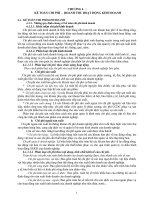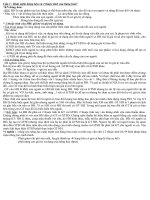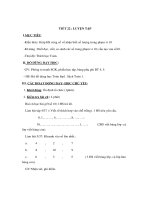Eng 2-2 NH (10-12-09) doc
Bạn đang xem bản rút gọn của tài liệu. Xem và tải ngay bản đầy đủ của tài liệu tại đây (90.36 KB, 4 trang )
I. True or False? Underline and correct the false ones (15points)
1. Bad debts include both late payers and non payments
2. The money the factor gives to the suppliers is bigger than the money the factor receives
from the buyer.
3. Three main forms of factoring are regulation of cash flow, full factoring and agency
factoring.
4. Wages and salaries are included in variable costs.
5. Having a wide range of products is a good point of a business.
6. From the supplier’s point of view, factoring is the activity of buying commercial debts at a
discount.
7. For a company, good management accounting should include credit accounts, sales
accounts, profitability accounts and consolidated credit account.
8. The value of an acceptance bill partly depends on the status of the importer.
9. The discount rate of a bill partly depends on the status of the accepting bank. The more
well-known the accepting bank, the lower the discount rate, the smaller the discount and the
smaller the value of the bill on the market.
10. When the exporter ships goods ordered by the importer, he has received the shipping
documents.
II. Word formation (15 points)
1. A confirmed credit must be an ……………… credit ( revocable)
2. One of the reasons why the open account method is not popular in international trade is that
there must be political and economic …………….in both countries. (stable)
3. Using the method of documentary collection, the collecting bank is not responsible for
checking the ……………. of the documents. (correct)
4. ……………………… is calculated as percentage not proportion (profit)
5. It is difficult to calculate the income from wine sales because of the …………………… of
beer price. (liberalize)
6. Leasing is advantageous to both ……………. and ………… (lease)
7. It is easy for this company to do credit control because it information is stored …………….
(system)
8. He is one of the biggest …………… who have invested in my company (invest)
9. They want to find out about the company’s management and its ……………. records
(finance)
III. Reorder the following passage to make a perfect process (10 points) – The first
step has been done for you as an example.
a, Then the supplier receives the invoice signed by the buyer which is called the unpaid
invoice.
b, At maturity, the factoring company sends the unpaid invoice bought from the supplier to
the buyer.
c, The buyer places an order to buy goods for his production.
d, If the factor accepts to buy the unpaid invoice, he pays money to the supplier.
e, IF the supplier needs money immediately for his further production, he takes the unpaid
invoice to the factor to discount.
f, The money is the face value of the unpaid invoice.
g, The supplier sends the goods to the buyer according to the order placed by the buyer.
h, And it includes the discount (the factor’s profit) and other costs added.
i, This money is less than the money the factor receives from the buyer.
j, The buyer pays money to the factor on the presentation of the unpaid invoice.
IV. Finish the following sentences (15 points)
If you give credit …………… your customer, it will give the rise to the problem
……………………………………………….
1. It is important to make sure there is enough money …………… the bank at the end
……………… each month to pay ………………… expenses (these costs are the same as
the operating costs)
2. The bank which issues the credit on behalf of the importer is ………………
3. Without recourse factoring means the factor will buy debts ……………… risk.
4. ………………… is a discount gives to a customer who makes ……………… payments
……………… cash.
5. The collecting bank ………………. payments on behalf of ……………….
6. A person who checks financial accounts is ……………………
7. The 2 main ways for a company to raise more capital are ……………… from banks and
seeking…………………….
8. Documentary collection is popular because……………………………………………
9. Free market is the place where there are many ……………………………. to supply
…………………………………
V. Fill in each gap with one suitable word (10 point)
Factoring in Vietnam
In the age of globalization, the Vietnamese businesses have to fight the strong (1)
___________ in order to be survival and well-established. That fact requires they (2)
____________________ their great effort to develop their products and services and diversify
their business. To adapt this condition, the only way for financial institutions in Vietnam (3)
________________ that they must apply the new regenerates. Factoring is (4)
________________ of them. In fact, regulations were issued only in 2004
_________________ Decision 1096-2001-QDNHNN of the State bank of Vietnam dated 6th
September 2004. However, factoring trade in (7) __________________ has seen a flurry of
activities. A growing number of banks are adding factoring to their services, (8)
________________ Vietcombank, ACB, Techcombank, Sacmonbak, and the subsidiaries of
some foreign banks such as HSBC, FENB - American bank, DPS,
Here are some main services of factoring provided by banks in Vietnam
- Insurance against all risks of a business. The business can avoid capital shortage (9)
_____________ by selling its debts to factoring companies
- Customers' sale-ledger management. Factoring companies assist customers with (10)
_________________ management or collection or payment of receivables
- Finance by purchasing the debtor portfolio of a business concerned with or without recourse.
VI. Read the passage and do as required (15 points)
Venture capital
As you know, new businesses, called start-ups, are all private companies that are not
allowed to sell stocks or shares to the general public. They have to find other ways of rising
capital. Some very small companies are able to operate on money that their founders - the
people who start the company - have previously saved, but larger companies need to get capital
from someone else. As everybody knows, banks are usually risk- averse. This means they are
unwilling to lend to new companies where there is a danger that they won't get their money
back. But there are firs specializing in finding venture capital funds for new companies. Some
venture capital or risk capital companies use their own funds to lend to companies, but most of
them raise capital from other financial institutions. Because of the high level of risk involved,
investors to start-ups usually expect a higher than average rate of return on their capital. If they
can't get quick return in cash, they can buy the new company's shares. If the company is
successful and later becomes a public company, which means it is listed on a stock exchange,
the venture capitalists will be able to sell their shares then at a profit. This will be their exit
strategy
Venture capitalists generally invest in the early stages of a new company. Some companies
need further capital to expand their business. This is often called mezzanine financing and
usually consists of convertible bonds or preference shares that receive fixed dividend
A. Choose the best answer (6 points)
1. "start-up" refers to
a. a new established company
b. a newly established company
c. new-established company
d. newly established companies
2. Venture capital means capital invested in a company -ad whose return
a. is always high
b. is always low
c. depends on how that company runs its business, making profit or loss
d. a, b, and c
3. A public company is
a. a private company
b. a company which is listed on a stock exchange
c. a company which is unlisted on a stock exchange
d. a, b, and c
B. Fill in the gap with the appropriate word/phrase from the above text (5 points)
1. As for the suppliers, factoring is a way of _______________ from unpaid invoices
2. Banks are usually ____________________ to make loans to new companies
3. Venture capitalists need an _____________________ -a way to get their money back after
a few years.
4. _________________________ is the second round of financing before a company joins a
stock exchange
5. ___________________________ are companies which are allowed to sell stocks or shares
to general public
C. Answer the questions (4 points)
1. Where can venture-capital companies get money to lend?
2. What is the advantage of preference share?
VII. Answer the following questions (10 points)
1. What are the differences between Sight draft and Tenor draft?
2. What does short term finance consist of?
3. What do you know about Shipping documents?
4. What does the discount of a bill depend on?
5. What are the differences between leasing and leas purchase?
VIII. Translate the following sentences into Vietnamese (10 points).
1. Hoạt động mua bán nợ trở thành cứu tinh (saviour) cho những khoản nợ khó đòi vì nó giúp
cho các công ty chủ nợ có thể tối đa hóa dòng tiền, giúp họ có số vốn lên tới 80% giá trị của các
hóa đơn chưa được thanh toán cho hoạt động kinh doanh tiếp theo và làm cho doanh nghiệp của
họ phát triển
2. Các doanh nghiệp có thể tăng vốn điều lệ hàng năm bằng cách giữ lại một phần lợi nhuận để
tái đầu tư và mở rộng sản xuât
3. Lợ thế và điều kiện thuận lợi cho sự phát triển kinh tế của Việt Nam, một nước đang phát
trine là sự ổn định về kinh tế và chính trị
* Translate the reading (from the beginning to "other financial institution") into Vietnamese









